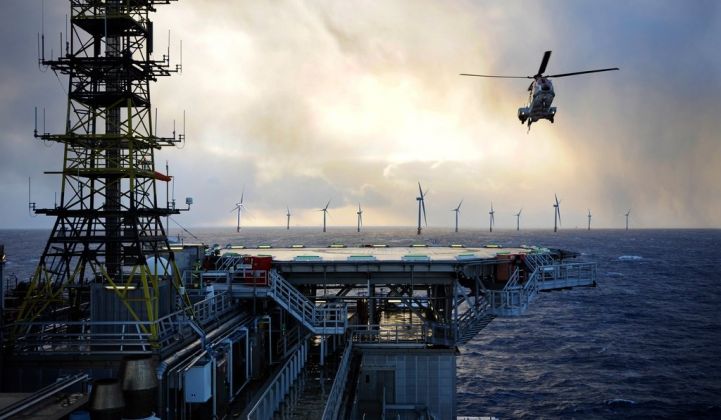The cost of floating wind farms is on a steeper decline than that of traditional offshore wind, with the emerging sector increasingly attractive to oil and gas companies, said Sebastian Bringsværd, head of floating wind development at Norwegian energy giant Equinor.
After years of industry anticipation, the floating wind market is finally gaining momentum in a commercially meaningful way. The goal, Bringsværd said, is to scale floating projects up to a comparable level as traditional projects, which are often 500 megawatts or larger, taking advantage of offshore wind’s huge economies of scale.
Just a few years ago that was an “ambitious” vision,” Bringsværd said. “Now I see that's very realistic.”
In its annual report released on Thursday, Equinor, among Europe's largest oil producers, laid out a new climate roadmap to keep it in line with the Paris Climate Accord, including plans to transform into a "global offshore wind major."
Equinor, among Europe's largest oil producers, intends to grow its fleet of renewable energy projects tenfold by 2026, to 4-6 gigawatts, on the way to 12-16 gigawatts by 2035. The Norwegian company, majority owned by the government, also pledged to halve the carbon intensity of its energy products by 2050.
Within the renewables sphere, Equinor carved out an early leadership position in the emerging floating wind sector, completing the industry’s first full-scale project several years ago, the 30-megawatt Hywind Scotland.
ACS Group’s 50-megawatt Kincardine Bay floating project, also off the coast of Scotland, will go into operation later this year, setting a new industry benchmark. And Equinor recently gave the green light to its 88-megawatt Hywind Tampen project off the coast of Norway, which will power two of its drilling operations upon its scheduled completion in 2022.
Hywind Tampen is a “stepping stone,” Bringsværd said. “It's providing the scale we need to prove the cost reduction curve — and it’s reducing our carbon footprint from our oil and gas production.”
"The figure the industry is aiming for is around €40 to €60 [$44 to $66] per megawatt-hour by 2030," he added.
While still a very expensive option for renewable power today, hovering around $250 per megawatt-hour by some estimates, floating turbines promise to unlock areas for wind development in waters too deep for regular monopile or jacket foundations. Among the technology’s obvious benefits is the ability for projects to tap the excellent wind resource often found far from shore while avoiding any visual impact from land.
In Hywind Scotland’s first two years of operation, it achieved a capacity factor of 56 percent. By comparison, the average for a U.K. offshore wind farm in 2018 was around 40 percent, according to government figures. Many onshore wind farms are at 30 percent or lower, and solar averages less than that.
California, France, Scotland and South Korea are all promising markets for floating offshore wind, Bringsværd said.
Wood Mackenzie expects 350 megawatts of floating offshore wind in operation by 2022 at various demonstration projects, and up to 10 gigawatts by 2030 with the right policy frameworks in place. Europe currently has a total of less than 50 megawatts of floating wind installed.

Sebastian Bringsværd, Equinor's head of floating wind development. (Credit: Equinor)
“In terms of timing, we are more than 10 years behind [fixed bottom offshore wind]; in terms of costs, we're ahead,” Bringsværd told GTM.
Equinor is also investing in traditional offshore wind, having last year won a contract for its 816-megawatt Empire Wind project in New York, as well as in onshore renewables. In its annual report released this week, Equinor said it plans to transform into a "global offshore wind major," aiming for 12 to 16 gigawatts of installed renewable capacity by 2035.
Floating wind's crossover appeal
Equinor is not alone among major energy companies in focusing on floating wind's potential.
“Experienced developers are starting to position themselves more aggressively in the floating industry by forging alliances and building up floating wind pipelines,” Rolf Kragelund, director of global offshore wind at Wood Mackenzie, wrote this week.
Among the recent collaborations is WindPlus, which includes Repsol, Engie, EDP and floating wind technology firm Principle Power. Shell recently bolstered its capabilities with the acquisition of the floating wind developer Eolfi.
“So far, the commercialization of floating wind has been hampered by a Catch-22, where developers argue that capacity is needed to reduce the cost of floating wind, while governments argue that cost declines are needed for governments to allocate capacity to floating wind,” Kragelund wrote.
But there are signs the impasse is starting to break. The ScotWind seabed leasing round, out later this year, will include a carve-out for floating projects in Scottish waters, and broader momentum is building for the U.K. to do the same through its contracts for difference program.
France is backing floating wind projects in a dedicated tender, at least partially prompted by the need to quell local opposition to near-shore turbines.
Meanwhile, EDP and Norwegian oil services firm Aker are exploring the development of a 500-megawatt floating wind complex off the coast of Ulsan, South Korea. The City of Ulsan would cooperate with the development of a waterside supply chain base. Equinor is part of a consortium eyeing a 200-megawatt project, Donghae 1, in the same region, with a potential commissioning date of 2024.
The U.K., in particular, has advantages both in historical deployment and its native supply chain, Bringsværd said. The technology that underlies floating wind is not especially new, and many of the competencies are an even stronger match for the existing oil and gas supply chain than with fixed-bottom offshore wind, he said.




